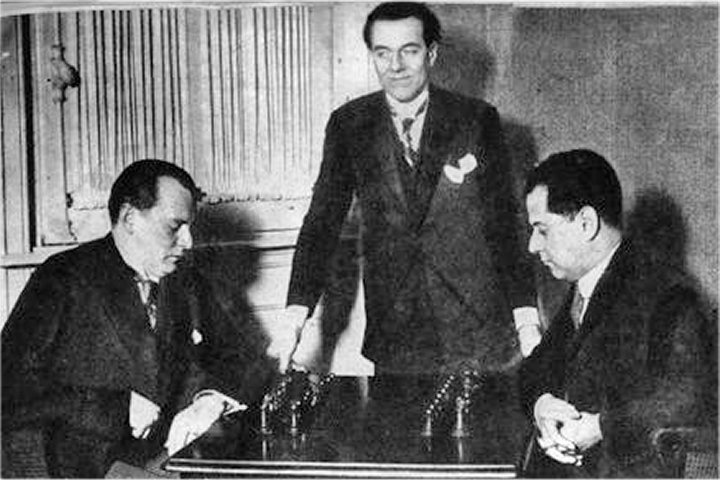Capablanca missed several drawing opportunities
Zoran Petronijevic: Conclusions about the game Alekhine-Capablanca, m/34 – 1927:
- Alekhine claimed that the position was won after the 23rd move but as Kasparov has shown Black should be able to hold though White is better.
- 23…Nc4 is a good move, and according to Kasparov "Black has a minimum of three more acceptable moves." Kasparov is correct, but in fact Black has at least four acceptable alternatives to 23…Nc4.
- Black's first major mistake is 26…Nc4. According to Kasparov it is "the only real mistake of Capablanca in this historical game." White now has an advantage, but it is not yet a decisive one.
- 29…Nxe4 is a serious mistake (according to Kasparov it is only a dubious move) that leads to a lost position. After 29…Ne8 Black has good chances to save the game.
- Alekhine failed to take advantage of the position and played 30.Nxe5, which is a mistake. Better is 30.Nxe4, after which White has a winning position.
- 30…Qd6 is very strong. Another interesting alternative was 30…Nxe5.
- Superficially, 32…Nd6 seems to be sound, but it is a mistake that once more leads to a lost position. Better was the active 32…Nd2, which should have saved the game.
- After 35…Rb8 Black is lost. The most stubborn move would have been 35…Ra6, organizing Black's defense on the 6th rank. However, Black is lost anyway but White needs to be very precise to win.
- 36.Re2 is a dubious one, after which White has to play very accurately in order to win. White has the much stronger 36.a5 after which he should win relatively easily.
- Instead of the text-move 36…Ra8 36…Rb6 was more stubborn. Still, after precise play, Black should lose.
- 37…Ra7 is dubious. More stubborn move 37…Kh7 to answer 38.a5 with 38...Ra6. However, Black should also lose after 37...Ta7, although it requires very subtle play by White.
- 38.Qc7 is a mistake which throws away White's advantage. It is interesting that no one until now has noticed that this move is a mistake. Kasparov’s suggestion 38.Qe1 neither leads to a win – the position is even. But after 38.Qa1! White wins.
- After 38…Qa6 the position is a draw as Black's pieces are excellently placed. Again, it is interesting that no one has previously evaluated this position as a draw.
- After 41.Rd7 the game was adjourned. White is better but Black should be able to hold.
- 41…Qb1, the first move after the adjournment, was a mistake! After 41…Rf5 Black has great chances to save himself. This was Capablanca’s last chance to hold the game. Now, Black’s position remains objectively lost until Capablanca resigned on move 82.
Wolfram Schön deals with the rook ending. He concludes:
"Besides the two main game commentaries of Alekhine and Kasparov, myriads of endgame books deal with the rook ending. Actually all endgame experts, with the notable exception of Mark Dvoretsky, have annotated it. From Rabinovich in the 1930s to Grivas (2020), including the most famous like Fine, Euwe, Levenfish/Smyslov, Averbakh, Karsten Müller in FCE or John Nunn in "Understanding Chess Endgames".
This game serves as a textbook example how to convert an extra outside passed pawn if the attacker's rook can get behind the pawn. The commentary usually starts with 54.Ra4. With the exception of Averbakh, for 95 years no one criticized any move or mentioned considerable alternatives for both sides before move 67.
So, I think, something is missing here in the endgame literature. With my investigation I think, I am able to present a bunch of new ideas, including evidence of at least 5 inaccurate moves.
- 50.Rxd4 White has a winning position, that is undisputed.
- 53.Rd4 It is not mandatory to put the white rook behind the passed pawn. 53.Rb5, ignoring Tarrasch's rule and keeping the rook at the side of the passed pawn, also wins quite comfortably.
- 56...h5 Criticised by Averbakh as a principle mistake. 56...Kd5 is possible, but should transpose to the game quickly, thus refuting Averbakh's statement.
- 57.Kd3 As the kings are in opposition, White can play a waiting move e.g. 57.Ra1. This is in accordance with winning plan outlined by theory, but shortcuts the winning process. Also the brute force approach with 57.f4+, with the idea of f4-f5, is possible.
- 59.Ra2?! The first inaccuracy. Putting the white rook on the 2nd rank causes problems. Better is 59.Ra1.
- 59...Kb5?! Failing to take the first chance to release the black rook from its miserable state by 59...Rf6!, which forces White to correct his set-up to stay on the winning track.
- 60.Kb3?! Increasing the problems. Besides the direct 60.Kd4, 60.Rb2+ is also possible.
- 60...Kc5?! Failing to take the second and best chance by 60...Rf6! This move offers fierce resistance and is a much better version of Capablanca's defensive plan in the game. White can win, but he has to work very hard.
- 61.Kc3 Connecting the king and the passed a-pawn with 61.Ka4 also wins.
- 62...Rd6+ The idea to defend the black pawns with the king, starting with 62...Kc6, is a serious alternative. White wins, but he should have a plan.
- 67.f4 The traditonal commentary only starts with concrete lines. White is clearly winning and he has many ways to do so, as has been pointed out correctly before. Alekhine's self criticsim from 1932 of his play in the last stage is a bit over the top."
Links


